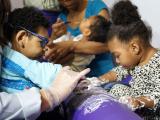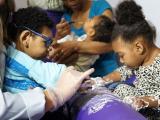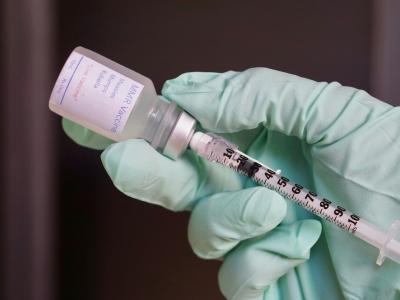A study described yesterday in a letter to The Lancet details microcephaly and extensive fetal brain damage in fetuses whose amniotic fluid tested positive for Zika virus during French Polynesia's 2013-14 Zika outbreak, results similar to Guillan-Barre syndrome (GBS) findings reported in the same journal the day before.
The report comes as the World Health Organization (WHO) published guidance on Zika and pregnancy management.
Also, a case report yesterday in a second letter to The Lancet details the presence of Zika virus particles in the breast milk of a New Caledonian woman infected with the virus last year, but no infection was noted in her baby. And rounding out the trio of letters is one criticizing Brazil's approach to controlling the mosquito that is the primary culprit in Zika spread, Aedes aegypti.
Microcephaly and other disorders
The first Lancet letter details findings in four fetuses in French Polynesia whose amniotic fluid tested positive for the virus during the territory's Zika outbreak from September 2013 through March 2014.
Three of the fetuses had microcephaly, or small heads. The fourth had a thin corpus callosum, which is the bundle of fibers that connects the brain's two hemispheres and aids in cognitive and other activity between the two sides of the brain. The three fetuses with microcephaly had an absent corpus callosum.
The fetuses with microcephaly also had a brain condition known as abnormal gyration. The researchers, from France and French Polynesia, noted that this anomaly, as well as the absence of a corpus callosum, "could reflect an early embryologic hit of the developing brain." The mothers of three of the four babies—including the mothers of two who had microcephaly—had Zika infection in the first trimester.
The fetus without microcephaly also had a brain disorder called ventricular dilatation, which two of the other fetuses also had on neurologic imaging. The fetuses with microcephaly had four to six neurologic abnormalities each.
The authors of the letter note that only two instances of severe fetal brain damage were reported in Brazil as the outbreak ramped up there in January.
They write, "It is likely that the true incidence of severe forms of fetal infection has been underestimated in our Polynesian population as we were unable to test all cases retrospectively." They report that 13 cases of fetal cerebral anomalies were diagnosed in French Polynesia in 2014, compared with 4 in 2013 and 3 in 2012. They were able to retrospectively assess six amniotic fluid samples, four of which tested positive for Zika virus.
The authors conclude, "Because of the potential severity of fetal lesions, fetal neurosonography should be considered from the second trimester in cases of maternal proven Zika virus infection, to detect subtle cerebral anomalies that might precede the onset of microcephaly."
Today's WHO guidance for pregnant women agrees: "Ultrasound investigations to identify, monitor, or exclude fetal brain abnormalities, particularly microcephaly, are recommended for all pregnant women living in areas with ongoing Zika virus transmission. All women should be offered an 18-20 week anomaly scan by a health care provider with experience in prenatal ultrasound diagnosis."
The WHO guidance also offers case definitions for Zika-related microcephaly and recommendations for pregnant women whose fetuses have microcephaly or other brain abnormalities.
On Feb 29 researchers from French Polynesia and France who conducted a case-control study reported a strong link in adults between Zika infection and GBS, another neurologic condition.
Virus confirmed in mother's milk
The second letter, from scientists in New Caledonia, a French territory in the South Pacific, describes a 27-old-woman who had a fever but no other symptoms when she entered the hospital and gave birth to a healthy baby, whom she immediately breastfed. After she delivered her infant, the woman remained febrile for 2 days and had a maculopapular rash, which involves redness and small connected bumps.
The fever and rash resolved, and she and the baby were discharged from the hospital.
Researchers noted that both blood samples taken on day 3 of hospitalization and breast milk samples from day 4 tested positive by polymerase chain reaction for Zika virus RNA, a finding that has been noted before.
The investigators, however, were able to take the next step to determine a potential risk to newborns. They inoculated the woman's breast milk onto Vero cells, which are frequently used to culture viruses. They were then able to detect infective viral particles from the milk sample in rather high quantities (39 million RNA copies per milliliter).
Zika guidance from the US Centers for Disease Control and Prevention (CDC) published before this new finding states, "Zika virus RNA has been identified in breast milk, but attempts to culture the virus have been unsuccessful."
Guidance from the WHO is contradictory on this point. Its most recent breastfeeding guidance, on Feb 25, says, "Zika virus RNA has been detected in breast milk from two mothers with confirmed Zika virus infection, but no replicative virus was identified in cell culture." A Feb 10 Q&A document, however, says, "Zika virus has been detected in breast milk."
Both the CDC and WHO agree there is no evidence of Zika virus infection from breastfeeding, and they both encourage early breastfeeding.
Peggy Hoenin, PhD, MPH, the co-team lead for the CDC's Pregnancy and Birth Defects Team and part of the agency's Zika response team, told CIDRAP News that Zika transmission via breast milk is theoretically possible, but transmission by mosquitoes is by far the greater danger. "The most important message is that both women and children should be protected from mosquito bites," she said.
The baby noted in the Lancet letter remained clinically normal throughout the hospital stay, and blood samples from the infant from day 3 were "ambiguous."
The authors conclude, "Arbovirus transmission via breastfeeding has been previously suggested for dengue, West Nile, and yellow fever, but more information is needed. Zika infection in woman during pregnancy or during the perinatal period must be considered very seriously by practitioners."
Aedes control in Brazil
In the third letter, researchers primarily from Brazil say the Brazilian government is focusing on a chemical-centered assault on Aedes mosquitoes that has not worked in the past to control dengue, which is also transmitted by A aegypti.
The scientists write, "The approach applied so far by the Government uses large resources on inefficient or unsafe vector control methods, instead of improving urban infrastructure and environmental sanitation, with a stable supply of potable water. Relying on a chemical war against the vector tends to pacify the population with false security, while a broad programme for better sanitary urban conditions could generate social mobilisation and co-responsibility of the population."
They say that improving sanitary conditions is a long-term investment in public health, while pesticides will need to be reapplied. They also write that the government's approach is centralized, is vertical, and doesn't factor in deep social divides. Only 28% of rural populations are connected to a public water supply, the authors note, so they have to store water at home in containers that can serve as Aedes breeding grounds.
See also:
Mar 1 Lancet letter on brain abnormalities
Mar 2 WHO guidance for pregnancy management and Zika
Mar 1 CIDRAP News story "Study shows strong link between Zika infection, GBS"
Mar 1 Lancet letter on breast milk
CDC guidance on Zika transmission in children
Feb 26 WHO guidance on Zika and breastfeeding
Feb 10 WHO Q&A
Mar 1 Lancet letter on Aedes control


















